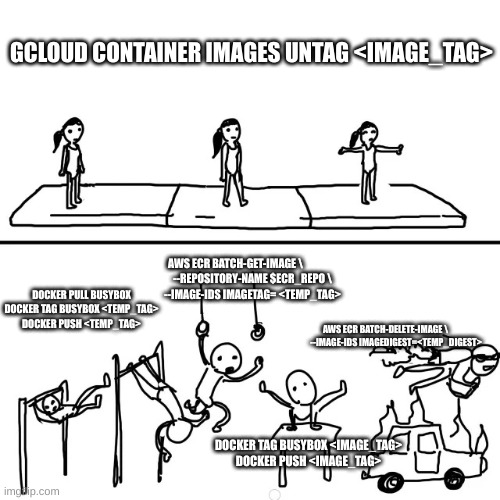Have you had any luck with projectors for coding? I've only ever used them for large mob-programming sessions, like during hackathons. I feel like the low/narrow contrast of projectors makes it hard to use for dark mode, not to mention the space real estate requirements. :P
Still kind of sad that the transflective display technology demoed in the $100 laptop project from a decade or so ago never took off.
Personally, I've been happy using an LG TV for a single monitor setup. I have had to switch to KDE Plasma v6 for better font rendering given its unusual OLED pixel layout, as well as for native HDR support. But it's been nice to have a large physical font while still at default DPI. Although, I wouldn't't mind upgrading to 8K later when they get affordable, as the smallest 4K TVs at 42" happen to push the physical DPI down towards that of just 1440p panel.
Tagging an image is simply associating a string value to an image pushed to a container registry, as a human readable identifier. Unlike an image ID or image digest sha, an image tag is only loosely associated, and can be remapped later to another image in the same registry repo, e.g latest. Untagging is simply removing the tag from the registry, but not necessarily the associated image itself.
Ah man, I'm with a project that already uses a poly repo setup and am starting an integration repo using submodules to coordinate the Dev environment and unify with CI/CD. Sub modules have been great for introspection and and versioning, rather than relying on some opaque configuration file to check out all the different poly repos at build time. I can click the the sub module links on GitHub and redirect right to the reference commit, while many IDEs can also already associate the respective git tag for each sub module when opening from the super project.
I was kind of bummed to hear that working trees didn't have full support with some modules. I haven't used working trees with this super project yet, but what did you find about its incompatibility with some modules? Are there certain porcelain commands just not supported, or certain behaviors don't work as expected? Have you tried the global git config to enable recursive over sub modules by default?
Didn't know about this case history with Nintendo, nor the name for the common exploit used:
I was more curious about horizontal/vertical scroll snapping of text, given if the underlying vim properties are still limited to terminal style rendering of whole fractions of text lines and fixed characters, then it's less of a concern what exactly the GUI front end is.
Are you using the PWA, self hosted or via code spaces/other VPS? With which web browser?
I tried hosting code server via termux for a while, but a user proot felt too slow, even if the PWA UI ran silky smooth.
Perhaps when my warranty runs out I'll root the device to switch to using a proper chroot instead.
Do you use it combined with terminal emulators?
Wouldn't that result in vertical scroll snapping to textual lines, and horizontal scroll snapping to character widths?
A personal preference I suppose for navigation, but a bit jumpy to read from while moving rapidly.
Only just got a 120Hz monitor recently, so reading scrolling text now is so much easer and faster than before. Looking forward to any IDE that can match that kind of framerate performance as well.
Too bad I don't own a mac to be able to test out the current release of Zed as an IDE. However, I'm not sure about the growing trend of rasterizing the entire GUI, as compared to conventional text rendering methods or GUI libs with established accessibility support.
You could get a fiber optic display/HDMI cable, a fiber optic USB cable, and the USB hub, then just move the desktop tower into another room and run the cables through the walls or ceilings to your display setup. Might only be $100 or so cheaper than then a used business thin client, but at least you could still do something 4K 120Hz HDR 12bit over some distance without compromise. E.g:

Could you explain a little more on that? Just curious.